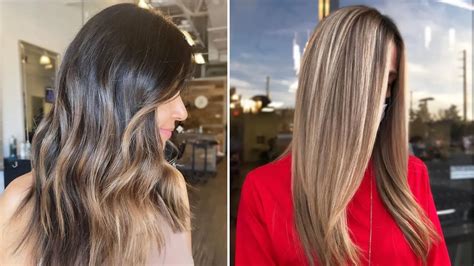The world of hair coloring is a vast and ever-evolving canvas, where techniques like balayage and highlights have emerged as popular choices for adding depth, dimension, and personality to locks. While both techniques involve the application of color, they differ in their methods and results. Here’s an in-depth exploration of the nuances between balayage and highlights:

1. Application Technique: Freehand vs. Foiling
Balayage:
– Employs a freehand painting technique, where color is hand-painted directly onto the hair.
– Strands are selectively lifted, creating a natural-looking, sun-kissed effect.
Highlights:
– Involves the use of foils to isolate and lighten specific sections of hair.
– Foils create a precise and controlled lightening process, resulting in defined and evenly distributed highlights.
2. Placement: Root-to-Tip vs. Mid-Length to End
Balayage:
– Typically applied from root-to-tip, creating a seamless blend of shades.
– Focuses on creating a gradient effect, with lighter hues concentrated towards the ends.
Highlights:
– Generally placed in mid-lengths to ends, resulting in a more defined and contrasting effect.
– Highlights are often used to frame the face or add streaks of color.
3. Result: Natural vs. Dramatic
Balayage:
– Aims to achieve a subtle and natural-looking finish.
– Blends colors seamlessly, creating a soft and diffused effect.
– Ideal for those seeking a low-maintenance, lived-in look.
Highlights:
– Produces a more noticeable and dramatic lightening effect.
– Creates defined stripes or blocks of color, resulting in a more dimensional appearance.
– Suitable for individuals who desire a bolder and more statement-making look.
4. Maintenance: Frequency and Touch-Ups
Balayage:
– Requires less frequent touch-ups due to the root-to-tip application.
– As the hair grows out, the balayage seamlessly blends, preserving a natural-looking effect.
– Generally recommended for touch-ups every 4-6 months.
Highlights:
– Needs more frequent maintenance as the highlighting technique creates a defined contrast.
– Root growth can become more noticeable, necessitating touch-ups every 2-3 months.
– Regular touch-ups are essential to maintain the desired look.
5. Cost: Budget-Friendly vs. Premium
Balayage:
– Typically more expensive than highlights due to the time-consuming freehand application.
– Requires skilled professionals who specialize in the technique.
– The cost can vary depending on factors such as hair length, desired level of lightening, and salon location.
Highlights:
– Generally more budget-friendly compared to balayage.
– The use of foils streamlines the process, making it less time-consuming.
– The cost varies based on similar factors as balayage, including hair length and salon rates.
Common Mistakes to Avoid When Choosing Between Balayage and Highlights:
- Mistaking Balayage for Ombré: While balayage and ombré share some similarities, they are distinct techniques. Balayage creates a gradual blend, while ombré involves a more pronounced shift in color from roots to ends.
- Over-Processing: It’s essential to consult with an experienced hair stylist to determine the optimal processing time for both balayage and highlights. Over-processing can lead to hair damage.
- Improper Application: The placement and application of color are crucial for achieving the desired results. Ensure that the stylist is skilled in the technique you choose.
- Ignoring Hair Type and Condition: Balayage and highlights may not be suitable for all hair types and conditions. Consult with a professional to assess your hair’s health and suitability for these techniques.
FAQs:
-
Can I do balayage or highlights at home?
– While it is possible to attempt these techniques at home, it’s highly recommended to seek professional assistance to ensure proper application and avoid potential hair damage. -
Which technique is more suitable for short hair?
– Highlights are generally more effective for shorter hair as they can create more precise and visible contrast. -
How long does balayage or highlights last?
– The longevity of balayage and highlights varies depending on factors such as hair growth, maintenance routines, and environmental factors. Proper care and touch-ups can extend their lifespan. -
Can I use bleach for balayage or highlights?
– Bleach can be used to achieve lighter shades, but it should be used carefully and under the guidance of a professional stylist to prevent hair damage. -
Which technique is less damaging?
– Balayage tends to be less damaging than highlights as it uses a more gradual lightening process and avoids direct contact with the roots. -
Can I dye my hair after balayage or highlights?
– Yes, you can dye your hair after balayage or highlights, but it’s important to wait an appropriate amount of time and consult with a stylist to ensure compatibility and prevent damage. -
How can I choose the right balayage or highlights color for my skin tone?
– Consider your skin undertones (warm, cool, or neutral) and consult with a stylist to determine the most flattering color choices. -
What are the latest trends in balayage and highlights?
– Recent trends include rooted balayage, lived-in highlights, and icy blonde shades. Consult with a stylist to stay updated on current styles and techniques.
Conclusion:
Balayage and highlights are both versatile hair coloring techniques that can enhance the beauty and personality of your locks. While balayage offers a natural and low-maintenance look, highlights create a more dramatic and defined effect. Understanding the key differences and consulting with a skilled hair stylist will empower you to make an informed decision and achieve the desired hair transformation that aligns with your style and preferences.
